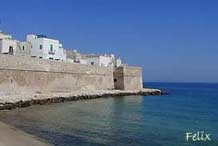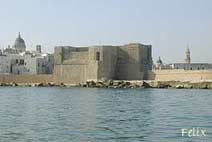|
|
 |
| ARTE
E CULTURA - The Town yesterday |
THE TOWN YESTERDAY
| Monopoli
reveals a distinguished past. From the Greek “Mono-polis”
, unique town, it was a little village of the ‘Peucezia’
Apulia next to another important village of the Land,
‘Gnatia’. In 545 d.C. the inhabitants
of Gnatia reached Mono-polis after Totila, king of
the Goths, ordered the distruction of their whole
village. In the following centuries a great part of
Southern Italy saw the settlements of Normans, Byzantines
and Swabians.
|
| 
|
| In
1484, with the settlement of Venetians, Mono-polis
knew a period of remarkable economic growth thanks
to the development of its harbour activities above
all. The harbour was considered to be the sole safe
and equipped refuge between Bari and Brindisi and
an import-export trade centre of a great number of
goods, because of its strategic position.
In 1530, after the end of the Venetian domination,
the Emperor tried to make Monopoli a Barony or a Marquisate,
but he faced the firm opposition of the people of
Monopoli, who decided to redeem themselves, paying
51000 gold ducats to the Emperor.
|
 |
In
1545 Monopoli became a free town again under the spanish
domination. It then acquired and enlarged a circuit
of defensive walls and towers and the Marquese Don
Ferrante Loffredo, to order of King Carl V, restored
the ancient castel of Enrico IV and Federico II. The
spanish domination, which ended in 1713, was replaced
by the Austrian one which ruled Southern Italy late
till 1734, when the Bourbon settled the Reign of Naples.
Subsequently, Monopoli was part of the Reign till
1860, when it was enclosed in the Reign of Italy.
|
| |
|
BACK
(Traduzione curata dalla laureanda Marilisa
L’Abbate durante il tirocinio formativo).
|
|
 |
|